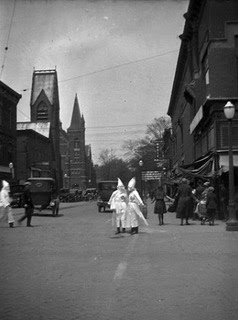Jeff Gill
Missing stories and broken fragments
___
When I discussed the beginning of the public efforts of the Ku Klux Klan in Licking County, one hundred years ago in January, I knew it would provoke some interesting and I hope useful discussions.
Right from the outset, both in my own social media posts and in this column, I've been hearing back from people who have heard these same stories, and seen the same robes and hoods in family closets (the Klan actually called them "helmets" with "detachable visors," but I'll mostly call them hoods and masks).
I'm talking about stories shared within families and tales told secondhand because there's an interesting gap in the official record. If you go to any library or archive, in person or online, you will find that the Newark Advocate is missing for most of 1923, all of 1924 and 1925, and the first months of 1926.
Year after year before back through the turn of the century, and after 1926 pretty much without a gap to the present day, but the pages of the "first draft of history" in our local daily paper are gone.
They were gone when I first went to the old Newark Public Library as I moved here in August of 1989, and I found the same at the State Archives a few months later in 1990. It's as if a methodical effort was made years ago to erase the published record of the period whose centennial we're passing through.
I went immediately to look what I could find on microfilm (waving at everyone in the audience who remembers microfilm readers, and cranking through history squinting at the images projected onto the hooded screens), or perhaps in older bound volumes, because I had done the same in my hometown of Valparaiso, Indiana in researching our Klan history there. In May of 1923 there was a massive Klan event in Valparaiso, a gathering of 50,000 or more which would only be eclipsed by a larger rally on July 4th in Kokomo, which totaled some 100,000 to possibly 200,000, in attendance from multiple states around the Midwest.
But if you read in the 1970s and 1980s as I did about Klan rallies of the 1920s, you also saw that there were not one but two "konklaves," or state assemblies at a place called Buckeye Lake, Ohio: first in that busy year of 1923 following the Kokomo rally, numbering around 75,000, and another in 1925 which exceeded 100,000.
Spoiler alert: after 1926, this "second era" Klan would collapse in a steaming pile of corruption and graft and rape and murder. The political gains of 1923 and 1924 would not save D.C. Stevenson, Grand Dragon of Indiana from his legal troubles, but not before he bought houses in a nice suburb of Indianapolis and on the shores of Buckeye Lake. The man who said in public, "I am the law" about the influence of his secret society and their thousands of supporters would go to prison, but not before releasing information about membership and officers and deals made with elected officials . . . in Indiana.
So we know a great deal through those court records about the Indiana Klan. In Ohio, not so much. The secret records all disappeared elsewhere after Stevenson's conviction. As I learned while expecting to read contemporary accounts from our local paper about the summer of 1923, someone made them all go away at some point.
Well, not all. Because there are other sources, if not local ones. And locally, even one hundred years later, people have their own stories, those of parents and grandparents and others who once donned robes and hoods and saluted a burning cross, right here in Licking County.
Putting those broken fragments together, a more complete picture comes into view. And one which draws together places like Valparaiso, Indiana and Newark, Ohio.
Jeff Gill is a writer, storyteller, and preacher in central Ohio; he's got a few more of these stories to tell, if you're willing to listen. Tell him what pieces you have at hand through knapsack77@gmail.com, or follow @Knapsack on Twitter.
Klan members in Valparaiso downtown on May 19, 1923



